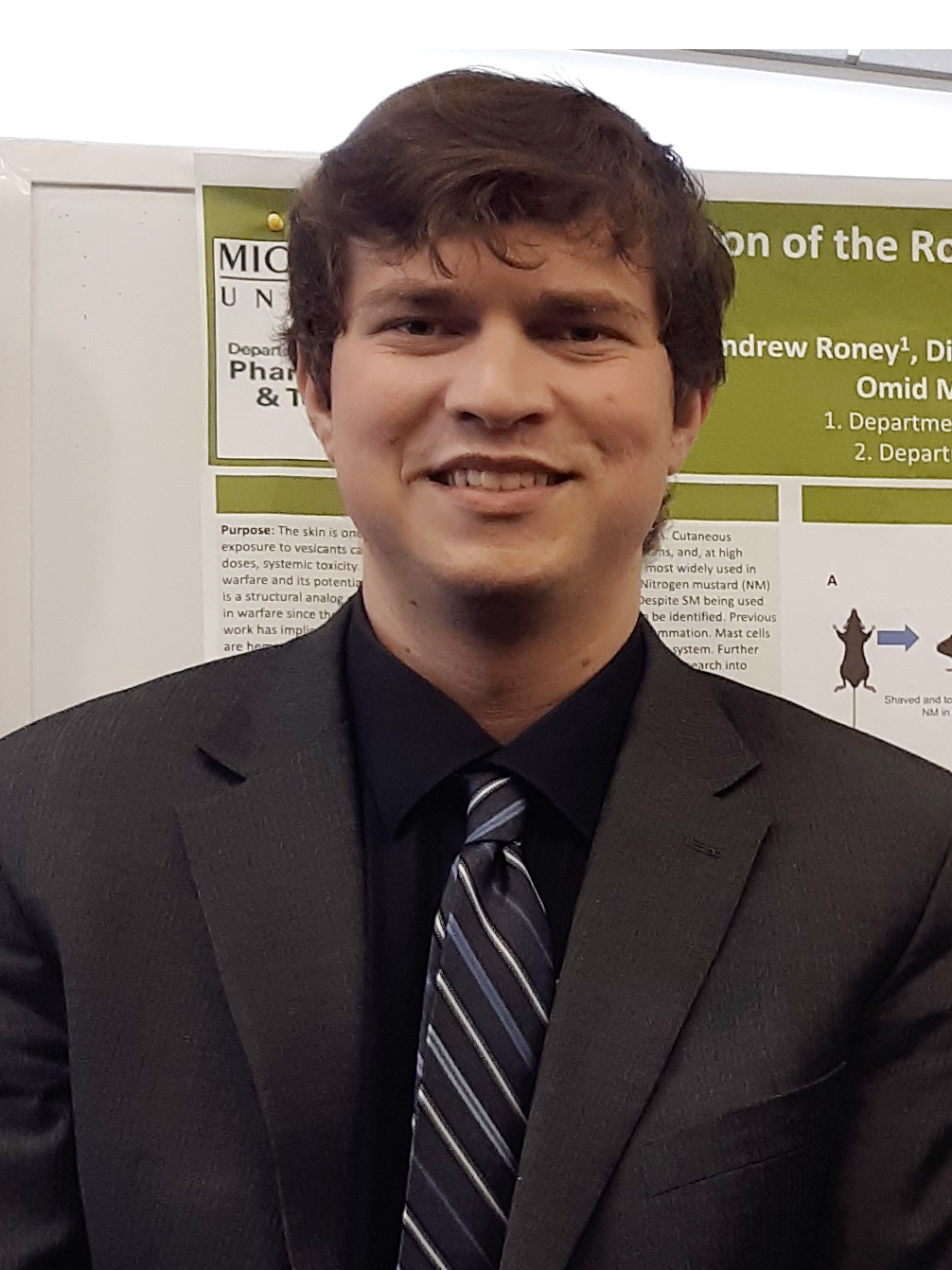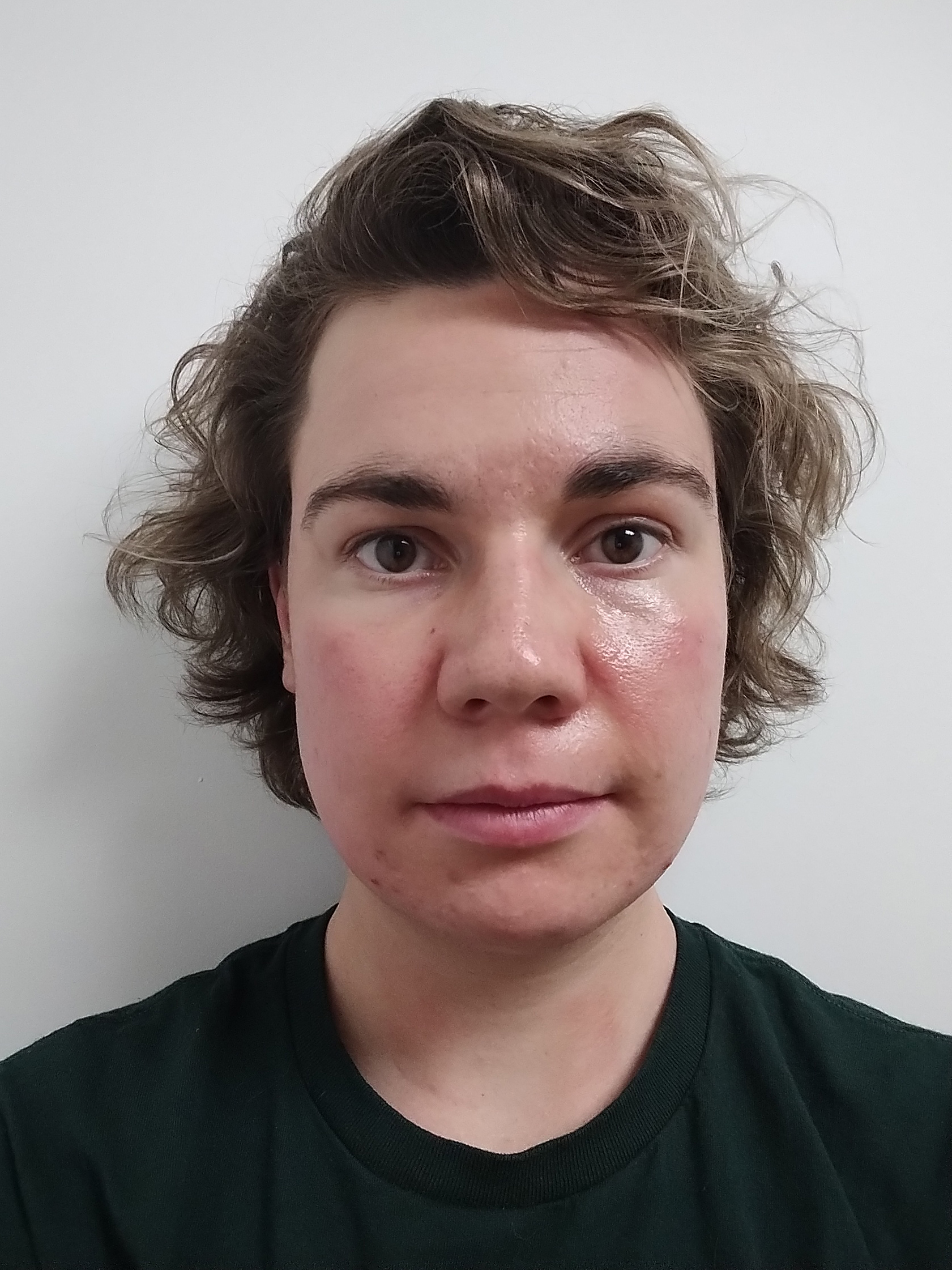Current EITS Students
Learn more about the research interests of our current EITS students by selecting their name below.
Biochemistry and Molecular Biology
-
Jesmin Ara
 Cooperating Doctoral Program: Biochemistry and Molecular Biology
Cooperating Doctoral Program: Biochemistry and Molecular BiologyEITS Track: Biomedical Toxicology
Education: Bachelor of Medicine, Bachelor of Surgery, Rajshahi University, Bangladesh
Research Interests:
My research interest focuses on elucidating the relationship between cholesterol and glucose homeostasis in TCDD-induced toxicity. Previous research from the LaPres and Zacherewski labs have demonstrated that mice given a 3-hydroxy-3-methyl-glutaryl-coenzyme A reductase (HMGCR) inhibitor (i.e. statin) display markers of increased TCDD-induced toxicity compared to TCDD alone. My research is focused on mechanistically linking changes in statin-induced changes in cholesterol homeostasis and the observed pathology induced by TCDD. To accomplish this goal, I will use in vivo models, both wild type and tissue-specific AHR knockout mice, and the human hepatocyte cell line, HepaRG.Major Professor: John LaPres, Biochemistry and Molecular Biology
Contact: arajesmi@msu.edu
-
Warren Sink
 Cooperating Doctoral Program: Cell and Molecular Biology
Cooperating Doctoral Program: Cell and Molecular BiologyEITS Track: Biomedical Toxicology
Education: B.S. Cell and Molecular Biology, Grand Valley State University
Research Interests:
My proposed doctoral research includes (1) the utilization of mouse thermoneutral studies to assess the progression of toxicant associated fatty liver disease (TAFLD) with broad implications of human nonalcoholic fatty liver disease (NAFLD) progression. Standard mouse toxicology studies are conducted at human thermoneutral temperatures (20 – 23°C) leading to unwarranted cold stress. By investigating the toxicological effects of 2,3,7,8-tetrachlorodibenzo-p-dioxin (TCDD) at 29 – 32°C, the progression of toxicant-induced liver disease is expected to mimic that more closely to human NAFLD pathologies. Work from my doctoral project with will include a collaboration with Dr. Arjun Krishan's lab (Computational Mathematics, Science and Engineering department) to employ (2) the application of contemporary data science techniques to integrate experimental datasets produced from -omic experiments, such as (but not limited to) RNA-seq, ChIP-seq, and metabolomics. Data generated as part of my project will (3) adhere to the implementation of Findable, Accessible, Interoperable, and Reusable (FAIR) guidelines by coordinating with the Data Management and Analysis (DMAC) core. These datasets will be further developed with the web-based application FAIRtox to provide researchers and the public the opportunity to interact with dose-dependent toxicological RNA-seq data, ChIP-seq, and, in the future, other -omic datasets.Major Professor: Timothy Zacharewski, Biochemistry and Molecular Biology
Contact: sinkwarr@msu.edu
Cell & Molecular Biology
-
Hoda Nouri Jevinani
Cooperating Doctoral Program: Cell & Molecular Biology
EITS Track: Biomedical Toxicology
Education: B.S. Cell & Molecular Biology, Shahid Beheshti University
Research Interests:
Parkinson's disease (PD) is the world's second most common neurological condition. The healthcare-related burden of PD is predicted to increase considerably over the next few decades as populations age. Although the prognosis has lately improved due to increased therapeutic availability, there is still no confirmed cure. While PD develops at random, 10% of patients are genetically predisposed. Mutations in the Leucine-rich repeat kinase 2 (LRRK2) gene are the most common cause of familial PD. LRRK2 is a large enzyme with both kinase and GTPase capabilities that interacts with approximately 260 proteins, participating in a wide range of cellular processes and signaling cascades.
1-methyl-4-phenyl-1,2,3,6-tetrahydropyridine (MPTP) is the most widely used prototypical neurotoxicant for studying the fundamental causes of PD in primates and rodents. MPTP treatment results in noticeable motor functional impairments, dopaminergic neuron death in the substantia nigra pars compacta (SNpc), a decline in dopamine transmitter levels, and increased activation of astrocytes and microglia in the striatum.
The Aryl Hydrocarbon Receptor (AHR) is a ligand-activated transcription factor that serves as one of the sensors enabling cells to adapt to their surroundings and microorganisms within the host. Previous research suggests that the AHR may have an important functional role in the development of Parkinson's disease, namely by contributing to neuroinflammation and motor impairment. Related investigations have also found that AHR has a role in the degenerative processes of MPTP-induced models of Parkinson's disease.
Previous work from our laboratory has demonstrated that loss of the AHR alters the expression of LRRK2, a key gene implicated in both familial and sporadic forms of PD, as observed in our MLE-12 cell model. Building on these findings, my project aims to investigate the role of AHR in modulating neuroinflammation and dopaminergic neurodegeneration in vivo using the MPTP-induced mouse model of Parkinson’s disease.
To dissect the functional relevance of AHR signaling, I will employ both genetic and pharmacological approaches, including AHR knockout mice and selective AHR agonists and antagonists, to determine how activation or loss of AHR influences MPTP-mediated neuronal injury, inflammatory responses, and Parkinsonian behavioral outcomes.
Major Professor: John LaPres, Biochemistry & Molecular Biology
Contact: nourihod@msu.edu
-
Zachary Smith
 Cooperating Doctoral Program: Cell & Molecular Biology
Cooperating Doctoral Program: Cell & Molecular BiologyEITS Track: Biomedical Toxicology
Education: B.S. Biochemistry & Molecular Biology, Michigan State University
Research Interests:
My tentative dissertation topic focuses on changes in metal homeostasis in the liver after dioxin insult and knockout of SLC7A11, a cystine-glutamate antiporter that is important for the biosynthesis of glutathione. Trace metals are vital for enzymatic function in processes such as electron transfer, DNA replication, and antioxidant defense. Constant aryl hydrocarbon receptor (AHR) activation by persistent organic pollutants, such as 2,3,7,8-tetrachlorodibenzo-p-dioxin (TCDD), result in hepatic transcriptome dysregulation. Changes in transporter and metalloprotein expression lead to trace metal imbalance and oxidative stress, potentially exacerbating liver damage. We aim to determine the effect of TCDD-induced AHR activation on trace metals in hepatocytes and the resulting systemic alterations in trace metal homeostasis in wild-type and hepatocyte-specific SLC7A11 null mice. Cystine transporter knockout will impede glutathione synthesis, assessing hepatocyte adaptation to toxicant induced oxidative stress. Altogether, we aim to determine if TCDD induces iron overload, leading to an induction of ferroptosis, and if this process is attenuated by the induction of SLC7A11.
Major Professor: Timothy Zacharewski, Biochemistry & Molecular Biology
Contact: smithz19@msu.edu
Chemistry
-
Jennifer Hinman
 Cooperating Doctoral Program: Chemistry
Cooperating Doctoral Program: ChemistryEITS Track: Biomedical Toxicology
Education: B.S. Chemistry, B.A. Biology, University of Nebraska at Omaha
Research Interests:
My research interests include studying how endogenous oxidized polyunsaturated fatty acid (PUFA) metabolites, also called oxylipins, affect age-associated neurodegenerative diseases. Throughout this work I will identify and study the corresponding mechanism of oxylipins that either accelerate or alleviate age-associated neurodegeneration, specifically the epoxy- and dihydroxy-metabolites of omega-3 (ω-3) and omega-6 (ω-6) fatty acids.
Endogenous oxylipins are crucial in human and animal physiologies as they are involved in CNS and cardiovascular functions, inflammation, and tissue repair despite their low abundance. As well, recent studies have indicated that chronic metabolic and neurodegenerative diseases could significantly impact the endogenous oxylipin profile in target tissues and inhibiting the metabolism of specific oxylipins could be beneficial to these diseases. In addition, several recent studies show that the exposome, such as a fatty acid diet, environmental toxicants, and everyday products, can impact oxylipin metabolism. Thus, in this specific project, I hypothesize that changes in the oxylipin profiles in C. elegans due to the exposome or aging consequently affect age-associated neurodegeneration. However, investigating the crosstalk between oxylipin metabolism and age-associated neurodegeneration in mammalian models and humans is challenging owing to the length of the experiments and difficulties to control potential exposures that could affect oxylipin metabolism. Therefore, in my thesis project, I propose to conduct our study in the model organism Caenorhabditis elegans (C. elegans) as the neuron signaling and PUFA metabolism of humans are conserved in C. elegans, their transparent body facilitates fluorescence neuronal imaging assays, and their relatively short lifespan expedites aging studies compared to other biological models. As well, C. elegans are genetically malleable and their diet can easily be modified to introduce a variety of compounds or varying fatty acid concentrations.
To test our hypothesis, we will analyze the oxylipin profile in C. elegans exposed to environmental toxicants at different ages to identify the oxylipins that are significantly impacted by exposome or aging. These identified oxylipins will then be supplemented to C. elegans allowing use to subsequently analyze how the exposome and aging affects neurodegeneration in C. elegans with phenotypic and morphological assays. By combining the results from these studies, we could delineate the mechanism behind how the exposome affects aging and age-associated neurodegeneration through PUFA oxylipin signaling pathways.
Here I propose to use state-of-the-art oxylipin profiling and neuronal function assays to i) identify specific metabolic changes in abundance within the oxylipin profiles throughout the lifespan that may be involved in aging, ii) determine the effect (i.e., severity, motor neurons affected, changes in lifespan) of these identified metabolites on neurodegeneration and neurodegeneration recovery, and iii) investigate a possible mechanism of ferroptosis, an iron-dependent programmed cell death that is characterized by an accumulation of lipid reactive oxygen species, to be responsible for the metabolic changes over the lifespan further resulting in the observed neurodegeneration. Once I establish the methodology for my research, and along with the study of oxylipins, I will then investigate how common yet toxic compounds (i.e., pesticides, metals, over-the-counter drugs, and personal care products) can affect aging and neurodegeneration with sustained exposure through the oxylipin signaling pathway. With these projects, I hope to elucidate the mechanism and progression of neurodegeneration due to these differences in fatty acid levels and exposure to environmental toxic chemicals in C. elegans that could translate to neurological diseases in humans, such as Parkinson’s and Alzheimer’s diseases. If these studies exhibit promising results corresponding to a causal effect between oxylipins and neurodegeneration in C. elegans, further studies could be conducted in more sophisticated mammalian models to support these results.
Major Professor: Kin Sing Lee, Pharmacology and Toxicology
Contact: hinmanje@msu.edu
Comparative Medicine and Integrative Biology
-
Dayita Banerjee
 Cooperating Doctoral Program: CMIB
Cooperating Doctoral Program: CMIBEITS Track: Biomedical Toxicology
Education: B.S. Microbiology and Cell Science, University of Florida
Research Interests:
Acetaminophen (APAP) overdose is the leading cause of acute liver injury or failure in the United States. Studies indicate that changes in the hemostatic system (coagulation and fibrinolysis), are connected to outcome in APAP overdose. My thesis project aims to define the mechanisms linking the fibrinolytic protease plasminogen to liver injury and repair, using APAP overdose in mice as an experimental setting. Whereas prior studies suggest that plasminogen contributes to APAP hepatotoxicity, my research suggests that plasminogen may have a protective role in APAP-induced acute liver injury. Contrasting published studies, I found that plasminogen deficiency exaggerates APAP-induced liver injury. My specific aims are to (i) determine the mechanisms whereby plasminogen reduces liver damage in APAP-induced acute liver failure and (ii) identify the mechanisms controlling plasminogen levels in plasma and liver after APAP challenge. My central hypothesis is that hepatic plasminogen binds to the extracellular matrix of the liver post-injury by a mechanism independent of traditional fibrinolysis. Using a series of tools, including plasminogen-depleting lipid nanoparticles, paired with novel catalytically inactive plasminogen mutant proteins, I will determine the precise mechanisms whereby plasminogen inhibits APAP-induced liver damage.Major Professor: James Luyendyk, Pathobiology & Diagnostic Investigation
Contact: banerj46@msu.edu
-
Rachel Sheffler
 Cooperating Doctoral Program: CMIB
Cooperating Doctoral Program: CMIBEITS Track: Food Toxicology & Ingredient Safety Track
Education: B.S. Veterinary and Biomedical Science, B.S. Nutrition, Pennsylvania State University, D.V.M. Michigan State University
Research Interests:
As a resident and graduate student in veterinary toxicology, I provide consultation services to veterinarians and pet owners for a variety of toxicology cases including accidental and malicious poisonings, environmental contaminants, and pet food complaints. In this role, I support both consumers and government agencies with testing recommendations and incident reporting to the Food and Drug Administration (FDA) Safety Reporting Portal. My current research efforts focus on testing cannabidiol (CBD) infused pet treats for cannabinoid content against manufacturer label claims. Currently, a federal regulatory pathway for cannabinoids in pet foods, feeds, and "supplements" does not exist. An aim of this dissertation is to establish a quantitative GC-MS/MS method for cannabinoid analysis in feed and treat matrices. My broader research interests include veterinary vitamin and mineral nutrition, nutrition and toxicology diagnostics and method development, wildlife toxicology, and veterinary pharmacology.Major Professor: John P. Buchweitz, MSU Veterinary Diagnostic Laboratory
Contact: sheffle5@msu.edu
-
Christine Wei
 Cooperating Doctoral Program: CMIB
Cooperating Doctoral Program: CMIBEITS Track: Biomedical Toxicology
Education: Biochemistry and Molecular Biology, Michigan State University
Research Interests:
Both chronic liver disease and acute liver injury can be induced by chemical exposures and in each context, the blood coagulation cascade is activated. Multiple studies suggest that components of the blood coagulation system modify the pathogenesis of acute hepatotoxicity and participate in the regeneration of the injured liver. My research is focused on defining the precise mechanisms linking the clotting protein fibrinogen to liver injury and repair.
After partial liver resection, the remaining liver regenerates, driven in part by hepatocyte proliferation, to restore normal hepatic functions. This surgical procedure is used to remove liver tumors and in the case of living donor liver transplantation. Interestingly, up to 10% of patients develop complications after partial resection. This can extend hospitalization time, and lead to serving complications including liver failure or death. After liver resection (partial hepatectomy, PHx), blood coagulation is activated, and fibrinogen is deposited in the liver. Prior studies suggest that failed hepatic fibrinogen deposition or low plasma fibrinogen after surgery is associated with post-operative liver dysfunction. Moreover, in the 2/3rd partial hepatectomy model in mice, fibrinogen depletion with ancrod significantly reduced hepatocyte proliferation. What’s more, prior studies also suggest the protein that degrades fibrinogen also contributes to hepatocyte proliferation, which further articulates the role of fibrinogen on hepatocyte proliferation. Although prior studies suggest that fibrinogen contributes to liver regeneration after PHx, the precise mechanisms are unclear. This is the focus of my research.
Major Professor: James Luyendyk, Pathobiology and Diagnostic Investigation
Contact: weizimu@msu.edu
Fisheries and Wildlife
-
Adrian Manliclic
Cooperating Doctoral Program: Fisheries & Wildlife
EITS Track: Environmental Toxicology Track
Education: B.S. Fisheries, Central Luzon State University
Research Interests:
My dissertation topic focuses on understanding the impact of emerging pollutants, specifically per- and poly- fluoroalkyl substances (PFAS), on fish health. In particular, my research interests are directed towards a comprehensive investigation of the interplay between PFAS exposure and its subsequent effects on disease susceptibility, disease progression/pathogenesis, immunological responses and overall survivability of prominent Great Lakes fishes including Lake whitefish, Lake trout and Steelhead trout.Major Professor: Cheryl Murphy, Fisheries & Wildlife
Contact: manlicli@msu.edu
-
Alexandra Swartz
 Cooperating Doctoral Program: Fisheries & Wildlife
Cooperating Doctoral Program: Fisheries & WildlifeEITS Track: Environmental Toxicology Track
Education: B.S. Environmental Science & Management, Environmental Studies and Sustainability, Michigan State University
Research Interests:
I am interested in research topics related to:- ecotoxicology
- environmental toxicology'
- bioassays
- risk perception and risk assessment
- individual based models in toxicology
- dynamic energy budget models
- toxicokinetic toxicodynamic models
- the role of ethics and values in toxicology
- science-policy interface, science communication and outreach, science education
Major Professor: Cheryl Murphy, Fisheries & Wildlife
Contact: asexton@msu.edu
Food Science and Human Nutrition
-
Maria Cinzori
 Cooperating Doctoral Program: Food Science & Human Nutrition
Cooperating Doctoral Program: Food Science & Human NutritionEITS Track: Biomedical Toxicology Track
Education: B.S. Animal Science, M.S. Epidemiology, Michigan State University
Research Interests:
My research interests center around the intersection between nutrition, toxicology, and pregnancy. I have a particular interest in the relationship between maternal obesity and endocrine disrupting chemicals (EDCs) and their impact on the anogenital distance (AGD) and 2:4 finger digit ratio (2:4D) of the offspring. Obesity is a prominent condition in the United States and an alarming number of women begin pregnancy as obese. This presents problems for the offspring because maternal obesity has been linked to increased risk for development of metabolic diseases and reproductive disorders. In the past, AGD and 2:4D ratios have been used as indicators of reproductive function later in life. The hormonal shifts in testosterone and estrogen resulting from obesity may alter the AGD and 2:4D of offspring, thus potentially providing a window into in-utero development and early biomarkers of reproductive disorders.
EDCs are near impossible to avoid and can be found in personal care products, cosmetics, plastics, and food wrappings. Recent studies with EDCs have shown that AGD and 2:4D reflect the uterine environment and could be useful in understanding the mechanisms and effects of EDCs and EDC alternatives on fetal development and maternal health. Ultimately, I would like to direct my research towards the interaction between hormones, EDCs, and women's health. Pregnancy is a critical period for both the mother and the fetus, but environmental factors- such as diet and chemical exposures- can have profound impact on a woman's health before and after pregnancy. Furthermore, the effects of these EDCs during pregnancy may contribute to the development of uterine fibroids, cardiovascular disease, and other health conditions.Major Professor: Rita Strakovsky, Human Nutrition
Contact: kloboves@msu.edu
-
Patricia Hsu
 Cooperating Doctoral Program: Food Science & Human Nutrition
Cooperating Doctoral Program: Food Science & Human NutritionEITS Track: Food Toxicology & Ingredient Safety Track
Education: B.S. Public Health and Agronomy, National Taiwan University
Research Interests:
I have a great interest in studying the global risk assessment of mycotoxins, especially aflatoxin, among different countries. I am currently working with Dr. Felicia Wu on a project called, “Aflatoxin M1 Health Risks vs. Benefits of Dairy Consumption in Ethiopian Children: An Epidemiological Trial and Risk-Benefit Analysis.” In this project, our goal is to provide sound risk and epidemiological science to the question of aflatoxin M1 (AFM1) in dairy products: what its true health effects are, how any health risks compare to the nutritional benefits of milk
consumption, and what the implications are for rational policymaking. Moreover, we hope to fill gaps in knowledge and policy surrounding aflatoxin M1.Additionally, my other research focus, “Sustainable, Systems-Based Solutions for Ensuring Low-Moisture Food Safety”, is mainly focusing on dealing the food recall problems of pathogenic bacteria (Salmonella) in low-moisture foods (almonds and raw flour). Through this study, based on the previous food recall cases that have occurred in the United States, we expect that
food product recall cases could be reduced by the improved traceability system, which involved with optimisation and models development. Moreover, we hope to estimate the economic loss resulting from the recalls of these two food products, thereby preventing the food recalls from happening repeatedly in the future.Major Professor: Felicia Wu, John A. Hannah Distinguished Professor, Department of Food Science and Human Nutrition, Department of Agricultural, Food, and Resource Economics
Contact: hsupin@msu.edu
-
Kelsi Morris
 Cooperating Doctoral Program: Food Science & Human Nutrition
Cooperating Doctoral Program: Food Science & Human NutritionEITS Track: Biomedical Toxicology Track
Education: B.S. Biology, Ripon College
Research Interests:
I am interested in understanding the extent to which pregnant women are exposed to various environmental chemicals through their diets, and how this exposure could impact their health and the health of their baby. Specifically, I am interested in studying the endocrine and metabolic health of women during pregnancy. To accomplish my research objectives, I will focus on expanding my expertise in both diet and environmental chemicals as determinants of pregnancy health. First, diet/nutrition is an important predictor of maternal and fetal health in pregnancy. Diet quality indices can be used to categorize whole diets rather than focusing on individual foods or nutrients, and this approach is more appropriate for understanding how diet impacts the health of pregnant women at the population level. Therefore, a major component of my training will focus on evaluating or developing pregnancy-specific diet quality indices to understand how whole diets impact the health of both mother and baby. Chemical exposures can occur through a variety of daily-use products, including but not limited to: makeup, personal hygiene products, and packaging. Food is one of these possible points of exposure, and more needs to be understood about the impacts of various chemicals in our food on the health of pregnant women. The class of chemicals known as endocrine disrupting chemicals (EDCs) is of particular concern, especially for expecting mothers, because pregnancy is a hormonally sensitive period. My research will also focus on understanding how EDCs impact pregnancy health/outcomes. Importantly, the ultimate goal will be to thoroughly evaluate the role of diet quality in predicting EDC exposure and to understand how this relationship contributes to pregnancy health.Major Professor: Rita Strakovsky, Human Nutrition
Contact: morrkel@msu.edu
-
Rachael Mthiko
 Cooperating Doctoral Program: Food Science & Human Nutrition
Cooperating Doctoral Program: Food Science & Human NutritionEITS Track: Food Toxicology & Ingredient Safety Track
Education: B.S. Food Science and Technology, Lilongwe University of Agriculture and Natural Resources, M.S. Food Science, Michigan State University
Research Interests:
My research interest is on the impact of dietary fiber chemical structure on its gastrointestinal fermentation and gut microbial community structure in humans. My interest is to assess the impact of polyphenolic compounds intrinsic to these fiber sources on their utilization, gut microbiome, and potential effects on the risk of chronic diseases such as cancer. Polysaccharides are polymeric molecules with long chains of monosaccharides units bound together by glycosidic linkages. They are mainly fermented by the large intestinal microbiota hence they play a role in improving the gut microbiome. This is important research due to its implications for human health and diseases, it will help us discover the strategies of promoting gut health, preventing diseases like obesity and many other things.Major Professor: Leslie Bourquin, Food Science & Human Nutrition
Contact: mthikora@msu.edu
-
Stav Kramer
Cooperating Doctoral Program: Food Science & Human Nutrition
EITS Track: Biomedical Toxicology Track
Education: B.S. Molecular & Cellular Biology, University of Illinois at Urbana-Champaign
Research Interests:
My research interests focus on understanding the impacts of environmental chemical exposures on maternal health and fetal development during pregnancy. Particularly, I plan to focuse on chemicals such as phthalates and per- and polyfluoroalkyl substances (PFAS), as pregnant women are exposed to these chemicals daily, particularly from their diet. I am interested in exploring how these exposures may influence key aspects of maternal metabolic health, which is important for both maternal and child short and long-term health. My first research project investigates both the sources and consequences of chemicals exposures by exploring whether eating outside the home is associated with higher chemical exposure, and how this contributes to maternal metabolic disruptions during pregnancy. By examining both dietary behaviors and resulting chemical exposure, I aim to find potential lifestyle factors that can be targeted to reduce environmental chemical exposures and thereby improve pregnancy outcomes.Major Professor: Rita Strakovsky, Human Nutrition
Contact: stavk2@msu.edu
Genetics & Genome Sciences
-
Srijana Shrestha
 Cooperating Doctoral Program: Genetics & Genome Sciences
Cooperating Doctoral Program: Genetics & Genome SciencesEITS Track: Biomedical Toxicology
Education: Bachelor of Technology, Biotechnology, Kathmandu University
Research Interests:
My research focuses on the role of spatial cellular heterogeneity in zone-biased steatotic liver disease or non-alcoholic fatty liver disease (NAFLD). The liver’s architecture is organized into metabolic zones formed by physiological gradients, such as oxygen and nutrients, from the portal vein to the central vein. These gradients result in distinct patterns of gene expression and function across the lobule. In NAFLD, steatosis often shows a zonal bias. It accumulates preferentially in either zone 1 or zone 3, depending on the etiology. However, the mechanisms underlying this spatial specificity remain poorly understood. My project aims to investigate how these spatial differences in cell function contribute to fat accumulation and liver dysfunction using both toxicant exposure models (PFOS and TCDD exposure) and dietary models (high-fat diet and methionine choline-deficient diet). I will be using advanced spatial and single cell transcriptomic techniques and bioinformatics data analysis to uncover location-dependent cellular responses that contribute to steatosis.Major Professor: Rance Nault, Pharmacology and Toxicology
Contact: shrest69@msu.edu
Microbiology, Genetics & Immunology
-
Vanessa Estrada
 Cooperating Doctoral Program: Microbiology, Genetics & Immunology
Cooperating Doctoral Program: Microbiology, Genetics & ImmunologyEITS Track: Biomedical Toxicology
Education: B.S. Biochemistry, California State University, Northridge
Research Interests:
Dr. Pestka's lab research regarding silica exposure aligns with a personal experience. One of my family members was occupationally exposed to silica and developed fibrosis which ultimately led to his passing. Because of this, I am interested in the modulation of silica induced autoimmunity by lipidome modification. I hope to further investigate not only the development of silicosis but of lupus as well, the autoimmune disease of interest in the Pestka lab. I hope to do this by bulk RNA sequencing lung tissues from previous graduate students to measure gene expression of epithelial cells. I also hope to conduct both in vivo subchronic and acute silica exposure, looking at mRNA expression in the lung. To further characterize disease development, I am interested in using different alveolar macrophage and lupus prone mouse models, than what is currently used in the lab.Major Professor: James Pestka, Food Science & Human Nutrition, Microbiology, Genetics & Immunology
Contact: estra100@msu.edu
-
Joel Marty
 Cooperating Doctoral Program: Microbiology, Genetics & Immunology
Cooperating Doctoral Program: Microbiology, Genetics & ImmunologyEITS Track: Biomedical Toxicology
Education: B.S. Biomedical Sciences, Western Michigan University
Research Interests:
With the implementation of combined antiretroviral therapy (cART) HIV prognosis has shifted to a manageable chronic disease. However, as this population of people with HIV age there is a correlated increasein neuroinflammation, which may contribute to the pathogenesis of HIV associated neurocognitive disorders (HAND). CD8+T cells are capable of crossing the blood brain barrier and potentially contribute to this inflammation. My project will assess the immunopharmacological nad immunotoxicological effects of cannabinoid treatment, specifically THC and JWH-015 (a selective CB2 agonist), on primary human CD8+T cells. Once the immunopharmacological/immunotoxicological effects of the cannabinoid treatment have been determined we will develop a coculture of primary human astrocytes with the cannabinoid treated primary human CD8+T cells.Major Professor: Norbert Kaminski, Pharmacology & Toxicology
Contact: martyjoe@msu.edu
Molecular, Cellular and Integrative Physiology
-
Chidinma Chukwukaeme
 Cooperating Doctoral Program: Molecular, Cellular and Integrative Physiology
Cooperating Doctoral Program: Molecular, Cellular and Integrative Physiology
EITS Track: Biomedical ToxicologyEducation: B.Sc. Physiology, Nnamdi Azikiwe University, Awka, Nigeria
Research Interests:
My research interests include lipid metabolism, obesity, and diabetes. Obesity and diabetes are significant risk factors for several comorbidities, including cardiovascular diseases. Brown adipose tissue (BAT) has emerged as a promising therapeutic target as studies in rodents have shown that increased BAT activity promotes energy expenditure, improves insulin sensitivity, and protects against diet-induced obesity and metabolic syndrome. BAT metabolizes linoleic acid, an essential omega-6 fatty acid, to produce lipokines like 12,13-dihydroxy-9Z-octadecenoic acid (12,13-diHOME). 12,13-diHOME acts as a signaling molecule that regulates nutrient utilization, thermogenesis, and insulin sensitivity, facilitating BAT function.My project aims to identify novel molecular targets for treating obesity by investigating how fatty acid uptake and metabolism in brown adipocytes are modulated. We are developing a high-throughput screening assay to screen potential drug candidates and environmental toxicants and evaluate their effects on BAT function and lipokine signaling. We will examine how exposure to environmental toxicants like Bisphenol A and excessive dietary intake of omega-6 polyunsaturated fatty acids, particularly linoleic acid, may dysregulate BAT-mediated lipid signaling pathways. We hypothesize that 12,13-diHOME is a key signaling molecule for BAT metabolism, and that environmental and dietary factors may disrupt its signaling pathway. By exploring how these factors influence lipid signaling in BAT, we aim to uncover the mechanism by which the total environment impacts obesity and metabolic syndromes and identify novel therapeutic targets for these disorders.
Major Professor: Kin Sing Lee, Pharmacology and Toxicology
Contact: chukwuka@msu.edu
-
Julia Jamka
 Cooperating Doctoral Program: Molecular, Cellular and Integrative Physiology
Cooperating Doctoral Program: Molecular, Cellular and Integrative Physiology
EITS Track: Biomedical ToxicologyEducation: B.S. Psychology, Minor Biology, Elmhurst College
Research Interests:
My research interests include the enteric nervous system (ENS) and how the brain and gut communicate. In my future research I will study how environmental toxins (ET) impact inflammatory conditions of the gut and how this may contribute to the onset of neurodegenerative diseases. During my PhD, I have an opportunity to become an expert in gut physiology while working in the Gulbransen lab. My thesis work aims to describe sex-based differences of enteric glial signaling mechanisms during health and disease. It is well known that ET are a source of gut inflammation becoming a major contributor to conditions related to the gastrointestinal (GI) tract. Enteric glia, though understudied, play key roles in neurotransmitter regulation, neuroprotective compound release, and communication with neurons and gut microbes. In addition to their diverse role in the ENS, GI disorders may be linked to sex-dependent glial mechanisms. For example, studies show female mice have a greater role of glia in motor circuits and stronger calcium responses after stimulation. In our lab, two methods induce enteric inflammation in mice: dextran sulfate sodium (DSS) and dinitrobenzene sulfonic acid (DNBS), modeling different inflammatory aspects. DSS causes epithelial barrier disruption, primary activation of the innate immune response, and has a deleterious impact on the microbiome. DNBS is associated with activating the adaptive immune response accompanied by a slower onset of more severe inflammation in the gut. In humans, intestinal bowel disease (IBD) has been associated with ET leading to weight loss, dysbiosis of the microbiome, epithelial barrier disruption, and onset of complex immune responses involving both the innate and adaptive immunity. By using DSS and DNBS protocols strategically, specific aspects of IBDs are modeled in mice which has led to a better understanding of the human pathology which has a complex etiology including environmental complications.Major Professor: Brian Gulbransen, Physiology
Contact: jamkajul@msu.edu
-
Kameron Kennicott
 Cooperating Doctoral Program: Molecular, Cellular and Integrative Physiology
Cooperating Doctoral Program: Molecular, Cellular and Integrative Physiology
EITS Track: Biomedical ToxicologyEducation: B.S. Microbiology, Michigan State University
Research Interests:
I have very diverse research interests, from XNAs (xenonucleic acids) in making artificial microbial genomes to designing novel therapeutics for human diseases, but I'll focus on my disseration topic. Autoimmune disease disproportionately affects women, but the environmental toxicants that trigger autoimmune flare-ups are generally occupational hazards in malebiased occupations: silicates & particulates (construction), UV light & pesticides/herbicides (agriculture), and smoke & industrial solvents (manufacturing). The discrepancy between this sex bias in disease and trigger reinforce the importance of genetics and sex hormones in the incidence of autoimmune disease, but may also hold key information in understanding the sex differences in immunity that drive autoimmune disease severity. If we treat autoimmune model mice with autoimmune flare-associated toxins, then they will show increased disease severity in a sex biased manner. To study this, I plan to use pristane-treated BALB/cJ and MRL/lpr mice to model autoimmunity, and then I will separate them by sex and treatment of one of the occupational toxicants. We're currently starting with glyphosate, the primary reagent in the herbicide, RoundUp, as it is quite ubiquitously used in American agriculture and has been linked with increased rates of Rheumatoid Arthritis in farmers who apply it. Following a 14-day oral gavage pretreatment with a chronic* 500mg/kg dose (*below the NOAEL limit of 885mg/kg for mice) starting when they are 6-8 weeks old, we will monitor the mice for the presence of autoantibodies in their serum, skin rashes, hunched back, decreased weight, and any other signs of autoimmune disease. We will sacrifice the mice at month 3 and evaluate their kidneys, spleen, plasma, brain, and other organs for disease. To do so, we plan to employ IHC/IF of inflammatory signals in kidney and other tissue slices, flow cytometry on blood immune cells, anti-nuclear antigen ELISA, and more to characterize the effect of the toxins on the disease. Further aims would repeat these experiments with different toxicants and frame the data against current policies and treatments for autoimmune patients.Major Professor: Yun Liang, Physiology
Contact: kennico2@msu.edu
Pharmacology and Toxicology
-
Saamera Awali
 Cooperating Doctoral Program: Pharmacology & Toxicology
Cooperating Doctoral Program: Pharmacology & ToxicologyEITS Track: Biomedical Toxicology
Education: B.S. University of Detroit Mercy
Research Interests: Nuclear factor erythroid 2-related factor (Nrf2) is a transcription factor that helps regulate antioxidant proteins involved in protection against oxidative and inflammatory stress. Studies show that Nrf2 demonstrates anti-inflammatory effects and plays a key role in decreasing susceptibility to chronic illnesses related to oxidative stress, thus it has been a therapeutic target of interest for several diseases. Data from our lab suggests that Nrf2 modulates T cell activation and CD8+ T cell effector function. Specifically, our lab has demonstrated that tBHQ, a potent Nrf2 activator, blunts the expression of CD107, a marker of T cell degranulation, on CD8+ T cells, suggesting that it impedes T cell activation and suppresses effector function. Although published data from our lab demonstrates a T cell autonomous role for Nrf2 in modulating T cell function, there is considerable evidence from other labs to show that Nrf2 also regulates antigen-presenting cells, such as dendritic cells. Notably, Nrf2 has been shown to regulate the T cell response by modulating dendritic cell activation induced by oxidative stress. In addition, it has been shown that dendritic cells lacking Nrf2 demonstrate increased expression of MHC class II, and the co-stimulatory molecules CD86, and CD80, which work jointly to promote T cell responses. Our hypothesis is that Nrf2 activation by tBHQ in dendritic cells will inhibit expression of MHC class II and other co-stimulatory molecules involved in effector functions, suggesting a blunted immune response after influenza infection. I intend to test this hypothesis in our mouse model of influenza and through the use of Nrf2-deficient models. I am concurrently developing in vitro assays to complement our in vivo approach.
Major Professor: Cheryl Rockwell, Pharmacology and Toxicology
Contact: awalisaa@msu.edu
-
Nana Kwame Kwabi Boateng
 Cooperating Doctoral Program: Pharmacology & Toxicology
Cooperating Doctoral Program: Pharmacology & ToxicologyEITS Track: Biomedical Toxicology
Education: Bachelor of Pharmacy, Central University, Ghana
Research Interests: My research interests lie broadly in Pharmacology and Toxicology, with a particular focus on the mechanisms of toxicity, hemostasis, and coagulation. My work explores fibrin(ogen) structure and function in response to acute tissue injury, aiming to understand how specific biochemical processes contribute to injury progression and recovery.
My dissertation topic will encompass, "Mechanisms controlling fibrin(ogen) crosslinking in tissue injury." I aim to specifically investigate the role of tissue transglutaminase in fibrin(ogen) crosslinking during tissue injury events such as acetaminophen toxicity. This research involves elucidating how tissue transglutaminase activity impacts fibrin crosslinking, contributing to tissue response in injury.
Major Professor: James Luyendyk, Pathobiology & Diagnostic Investigation
Contact: boatengn@msu.edu
-
Brianna Finn
Cooperating Doctoral Program: Pharmacology & Toxicology
EITS Track: Biomedical Toxicology
Education: B.S. Biochemistry, Michigan State University
Research Interests: Immunopharmacology/immunotoxicology of cannabinoids. Dissertation project will be in this general area, but the specific aims of the project will be determined in the near future.
Major Professor: Norbert Kaminski, Pharmacology & Toxicology
Contact: finnbri1@msu.edu
-
Samantha Musso
Cooperating Doctoral Program: Pharmacology & Toxicology
EITS Track: Biomedical Toxicology
Education: B.S. Biochemistry, Marist College
Research Interests: I am extremely interested in understanding the mechanisms of toxicity of environmental contaminants and the role these toxicants may play in the promotion of cancer. The focus on my research is to understand the interaction of risk factors such as obesity and environmental exposures on multiple myleoma. Specifically, obesity has been associated with increased incidence and progression of multiple myeloma, as well as decreased survival rate. Additional, environmental exposures can also lead to similar poor outcomes. To understand why obesity causes a more aggresive outcome and worse survival rates, it is important to better understand the mechanisms of fat, specifically if factors secreted from fat contribute to worse myeloma progressions. Moreover, it also necessary to better understand if increased levels of fat can lead to different responses following different types of exposures, such as exposure to PFAS chemicals or Ahr ligands.
Major Professor: Jamie Bernard, Pharmacology & Toxicology
Contact: smusso@msu.edu
-
Ebenezar Okoyeocha
 Cooperating Doctoral Program: Pharmacology & Toxicology
Cooperating Doctoral Program: Pharmacology & ToxicologyEITS Track: Biomedical Toxicology
Education: B.MLS. Medical Laboratory Science, University of Nigeria, Nsukka
Research Interests: My research interest is to elucidate the mechanism of chemical induced injury, and identify targeted treatment options.
Current study: Chloropicrin (Trichloronitromethane, CP), a toxic agent used during World War 1 as a warfare agent, is currently been used as a soil fumigant and pesticide. It is volatile and easily accessible, and this increases the probability of accidental and occupational exposure to CP, as well as its use in terrorism. Exposure to CP results in severe ocular injury, especially to the corneal. However, the mechanism of its injury is not well defined hence, treatment options are limited. Studies in our laboratory using human corneal epithelial (HCE) cells and ex vivo rabbit corneas suggests that GP-induced corneal pathogenesis is associated increased levels of nuclear erythroid 2-related factor 2 (Nrf2) and heme oxygenase-1 (H0-1 ), a critical target enzyme downstream of Nrf2, suggesting that the Nrf2 pathway, a key antioxidant and cytoprotective system, could be activated following CP exposure. My current study in Dr. Neera Tewari-Singh's lab is focused on establishing an in vivo mouse ocular injury model with CP. I will further define the role of the Nrf2 pathway in GP-induced ocular injury using Nrf2 knockout (KO) mice. As part of our lab's novel therapeutic approach, I will be employing Nrf2 activators alone or in combination with SSOE in the treatment of GP-induced ocular injury. I propose that understanding the role of Nrf2 pathway in vivo is a critical first step in identifying targeted therapy.
Major Professor: Neera Tewari-Singh, Pharmacology & Toxicology
Contact: okoyeoch@msu.edu
-
Andrew Roney
 Cooperating Doctoral Program: Pharmacology & Toxicology
Cooperating Doctoral Program: Pharmacology & ToxicologyEITS Track: Biomedical Toxicology
Education: B.S. Animal Science, Michigan State University; M.S. Comparative Medicine and Integrative Biology, Michigan State University
Research Interests: My research interests focus on the determining mechanisms of chemical warfare agent-induced toxicity and developing therapies for use in victims of chemical warfare agents. My dissertation research currently focuses on the role of mast cells in acute and long-term cutaneous and systemic injury arising from exposure to nitrogen mustard (NM), an analog of sulfur mustard (SM; the most widely used vesicating, or blister, agent).
Currently, my research focuses on examining the acute and long-term cutaneous and hematological effects of a single, topically applied dose of NM in C57BL/6 mice. The results of this study will lay the groundwork for further investigations using mast cell-deficient and Nrf2 knock-out mice to explore the roles of mast cells and the Nrf2 pathway, respectively, in NM-induced toxicity. The end goal of this research is to identify if masts and Nrf2 might be potential therapeutic targets for anti-NM/SM therapies and, if so, to identify practical therapies.Major Professor: Neera Tewari-Singh, Pharmacology & Toxicology
Contact: roneyand@msu.edu
-
Kamila Sadko
 Cooperating Doctoral Program: Pharmacology & Toxicology
Cooperating Doctoral Program: Pharmacology & ToxicologyEITS Track: Biomedical Toxicology
Education: B.S. Clinical and Applied Health Sciences, Drake University
Research Interests:My research interest is in computational cardiovascular safety pharmacology. Safety pharmacology is a subset of pharmacology specializing in detecting and investigating potential undesirable pharmacodynamic effects of new chemical entities on physiological functions in relation to exposure in the therapeutic range and beyond. It exists as the bridge between toxicology and pharmacology. Specifically, my dissertation aims to focus on the creation of a concentration-effect model of blood pressure in preclinical animal models. In 2018 the FDA released a draft clinical guidance proposing a new safety endpoint for consideration in drug development, increases in systolic blood pressure greater than 3mmHg. This guidance focuses on determining this effect in the clinical phases, and more specifically, in the patient population. However, due to the resource commitment of getting a molecule to clinical development, as well as the potential concern for determining drug toxicities directly in the patient population, it would be prudent to rule out such an effect in the preclinical.
Major Professor: Adam Lauver, Pharmacology & Toxicology
Contact: sadkokam@msu.edu
-
Sera Sermet
 Cooperating Doctoral Program: Pharmacology and Toxicology
Cooperating Doctoral Program: Pharmacology and ToxicologyEITS Track: Biomedical Toxicology
Education: B.S. Neuroscience, Michigan State University
Research Interests:
With the development of anti-retroviral therapy (ART), HIV has become a more manageable disease. This new treatment has successfully extended the life expectancy of the those afflicted with HIV to a life span comparable to a healthy individual. However, new problems arise as individuals live longer with HIV, such as development of HIV-associated neurodegenerative disease (HAND). Today, many individuals with HIV use cannabis to cope with side effects associated with the ART drugs. Previous research in the literature has shown that individuals with HIV who use cannabis have a decreased incidence of HAND development. My research will focus on elucidating the molecular mechanism of how cannabinoids induce their immunotoxicological and immmunopharmacological effects on the human immune system in the context of HIV.Major Professor: Norbert Kaminski, Pharmacology & Toxicology
Contact: sermetse@msu.edu
-
Natalie Vredevoogd
Cooperating Doctoral Program: Pharmacology & Toxicology
EITS Track: Biomedical Toxicology
Education: B.S. Biology, B.A. Geography, Calvin University
Research Interests: I am interested in ocular toxicology research. My dissertation topic will be pursing that research topic using a vesicating agent. My project will likely involve some wet lab molecular resaerch and some computational modeling, possibly using LC-MS to monitor the penetration of the toxicant into the tissue. I will also be performing some testing with more translational treatments for ocular pathology.
Major Professor: Neera Tewari-Singh, Pharmacology & Toxicology
Contact: vredev22@msu.edu
-
Congying Wang
 Cooperating Doctoral Program: Pharmacology and Toxicology
Cooperating Doctoral Program: Pharmacology and ToxicologyEITS Track: Biomedical Toxicology
Education: BS/MS Dual Degree Pharmacology and Toxicology, Minor in Neuroscience, University at Buffalo
Research Interests:
Research Topic: Coupled computational and bioengineered models of thyroid imbalance to support human chemical exposure risk-assessment.My current funded project aims to develop a human thyrocyte/hepatocyte screening model to elucidate the mechanisms by which chemical exposures disrupt thyroid hormone (TH) kinetics and action, ultimately supporting risk assessment at the population level. Various chemicals, including polychlorinated dibenzo-p-dioxins and dibenzofurans (PCDD/Fs) and per- and polyfluoroalkyl substances (PFAS), have been shown to disrupt TH balance in both humans and animals. To elucidate the mechanism by which chemicals exposures disrupt human thyroid kinetics and action, support risk-assessment, and understand of potential effects on human health with a population level, I am developing microphysiological thyrocyte/hepatocyte screening model and testing effects of chemicals and their mixtures. The project includes the following detailed aims. Aim 1. Elucidate PCDD/F-induced changes in thyroid kinetics and action in human hepatocytes. Aim 2. Engineer thyrocyte/hepatocyte model of TH synthesis and metabolism and test PCDD/F effects. Aim 3. Test for non-additive effects from chemical mixtures and predict populations susceptible to chemical disruption. A second portion of my dissertation is focused on testing chemical effects in neurodevelopment. Since TH play a crucial role in neurodevelopment, such as neuronal differentiation, myelination, and synaptogenesis. Any disruption in TH homeostasis can have profound effects on neurodevelopment and function. Based on my interests, experience, an existing collaboration and human health relevance, I am planning on expanding our testing systems to model neurodevelopmental diseases, and further aim to expand this work by developing a model to investigate how thyroid hormone imbalance contributes to neurotoxicity.
Major Professor: Brian Johnson, Pharmacology & Toxicology
Contact: wangco13@msu.edu
Plant, Soil and Microbial Sciences
-
Antryg Benedict
 Cooperating Doctoral Program: Plant, Soil and Microbial Sciences
Cooperating Doctoral Program: Plant, Soil and Microbial SciencesEITS Track: Environmental Toxicology
Education: B.S. Chemistry, George Mason University
Research Interests: I am researching the interactions of prions with geosorbents and heavy metals in order to better understand prion protein interactions and their fate in the environment and possible methods of remediation. Prions are infectious proteinaceous particles that are the sole agent of transmissible spongiform encephalopathies including mad cow disease, scrapie in sheep, and chronic wasting disease (CWD) in deer and other cervids. Prions can survive for years in the environment and remain infectious, and horizontal transmission of CWD through prions in soil, water, plant surfaces, and other matrices, is significant. One primary goal of my research is to explore the possibility that biochar and other carbon materials can serve as effective sorbents of prions, which could reduce their biovailability. To accomplish this, I am using computational simulations (molecular dynamics) to study the mechanisms of adsorption of prions to graphene (a model carbon surface) and binding strength. I also plan on comparing prion sorption to graphene and clay in order to assess how competitively carbon materials can bind prions in a soil environment. The second primary goal of my research is to study prion interactions with heavy metals, especially copper, which is known to interact with the prion protein. So far, I have conducted molecular dynamics simulations studying the binding sites of copper to the prion protein structure and conformational changes that occur due to copper binding.
Major Professor: Wei Zhang, Plant, Soil and Microbial Sciences
Contact: benedi89@msu.edu
-
Andrew Huang
Cooperating Doctoral Program: Plant, Soil and Microbial Sciences
EITS Track: Environmental Toxicology
Education: B.S. Agricultural Chemistry, National Taiwan University
Research Interests: My research interest focuses on the behavior of contaminants in the environment, and their fate, transport, and potential threat to human. Per- and polyfluoroalkyl substances (PFAS) are widespread, persistent contaminants posing potential threats to human health, and sorption of PFAS in soils influences their mobility and bioavailability in the environment.
According to previous research, the sorption of PFAS in soils was influenced by the salinity of soil solution, the soil pH, and the properties of soils and PFASs themselves. In my study, sorption experiments of PFAS in soils with various electrolytes and PFAS species will be carried out to study the effects of PFAS hydrophilic part(functional group) and the possible interaction mechanism. After figuring out the key factors, a soil column experiment will be carried out to simulate the PFAS transport in the environment. In addition, some adsorptive amendments to soils will be tested out in order to develop the strategy of reducing the PFAS mobility.Major Professor: Hui Li, Plant, Soil and Microbial Sciences
Contact: huangan7@msu.edu
-
Chenxi Li
Cooperating Doctoral Program: Plant, Soil and Microbial Sciences
EITS Track: Environmental Toxicology
Education: B.S. Environmental Microbiology
Research Interests: My research interest focuses on crop uptake of metal(loids) from soils as influenced by soil conditions and agricultural practices. While some metal(loids) such as lead (Pb), arsenic (As), cadmium (Cd), and chromium (Cr) are toxic to humans, some metal(loids) are essential to human health as appropriate dosage levels, including copper (Cu), manganese (Mn), zinc (Zn), and selenium (Se). My research aims to identify soil amendments that can decrease the crop uptake of toxic metal(loids) without jeopardizing the crop uptake of essential metal(loids). Further, I will use engineered nanomaterials such as sulfur nanoparticles and hydroxyapatite nanoparticles as soil amendments to decrease the crop uptake of toxic metal(loids). Finally, I will study how microbial communities and plant-microbe interactions contribute to the crop uptake of metal(loids) using culturing, genomic, and transcriptomic approaches The overall goal of my research is to promote the production of safe, nutritional crops using environmentally friendly and sustainable practices.
Major Professor: Wei Zhang, Plant, Soil and Microbial Sciences
Contact: lichenx1@msu.edu
-
Cao Qinyuan
Cooperating Doctoral Program: Plant, Soil and Microbial Sciences
EITS Track: Environmental Toxicology
Education: Bachelor, Beijing Normal University
Research Interests: My research interests focus on the study of various substances - such as heavy metals, nanoparticles, nutrients and other pollutants - in the environment, particularly on their accumulation in crops and other plants. Accumulation of toxic substances in crops poses significant risks to food safety and human health. Under this concern, I am especially interested in understanding the underlying principles about the movement and transformation of these substances within both environment and plant systems. My goal is to identify the way to minimize the accumulation of toxic substances in crops and protect our food safety.
Additionally, I am keen on employing computational methods to model the dynamics and changes in these substances. I want to use these tools to explore how factors such as season, weather, temperature, precipitation and so on, influence the movement and accumulation of these substances.
Major Professor: Wei Zhang, Plant, Soil and Microbial Sciences
Contact: caoqinyu@msu.edu
-
Yujie Wang
Cooperating Doctoral Program: Plant, Soil and Microbial Sciences
EITS Track: Environmental Toxicology
Education: B.S. Environmental Engineering, Beijing Normal University
Research Interests: My research primarily focuses on the uptake mechanism of per- and polyfluoroalkyl substances (PFAS) by plants, their transport in plants, and the distribution within plants, and PFAS bioavailability in soils for plant uptake. PFAS in soils can enter the plant’s vasculature via apoplastic, symplastic, and transmembrane pathways. The Casparian strip, which serves as a hydrophobic barrier between the apoplast and the vascular tissue, can block many compounds from entering through the apoplastic route. Therefore, the role of the Casparian strip in the uptake of PFAS by plants is worthy of investigation. To address this question, I will conduct hydroponic experiments, examine the distribution of PFAS within the plant and attempt to visualize the role that Casparian strip plays in this distribution using advanced visualization techniques.
Simultaneously, I aim to develop an optimized QuEChERS method to enable faster and more accurate analysis of PFAS concentrations. The results obtained using the QuEChERS method will be compared with existing methods, such as the 1633 method, to evaluate the feasibility of using QuEChERS for detecting PFAS. Will conduct greenhouse experiment to evaluate the bioavailability of PFAS in soil to plant uptake, and develop the strategy to mitigate PFAS bioaccumulation in plants.
Major Professor: Hui Li, Plant, Soil and Microbial Sciences
Contact: wangy370@msu.edu
-
Xu Zhiliang
Cooperating Doctoral Program: Plant, Soil and Microbial Sciences
EITS Track: Environmental Toxicology
Education: B.S. Environmental Sciences / B.A. Chemistry, University of Iowa
Research Interests: My research program is to study uptake and accumulation of poly- and perfluoroalkyl substances (PFASs) and pharmaceuticals and personal care products (PPCPs) in the agricultural food crops. These emerging chemicals are frequently present in biosolids derived from wastewater treatment plants (WWTPs). The land application of biosolids to agricultural land as soil amendments and plant fertilizers could bring PFASs and PPCPs into soils, which could subsequently enter food crops and accumulate in the edible parts. Consumption of PFASs- and PPCPs-contaminated food crops can result in some adverse health problems to humans, especially to toddlers and children. Specific to my research, I will determine PFASs and PPCPs in biosolids samples collected from the WWTPs across the U.S., and achieved grain samples produced from the lands that had received the repeating applications of biosolids. In addition, I will conduct greenhouse experiments to examine how much PFASs and PPCPs will be accumulated in several agricultural food crops from the soils amended with biosolids. These research studies are essentially needed, because this information will be beneficial to estimating the health risk of humans after eating the crops grown in the biosolids-amended soils.
Major Professor: Hui Li, Plant, Soil and Microbial Sciences
Contact: xuzhilia@msu.edu

